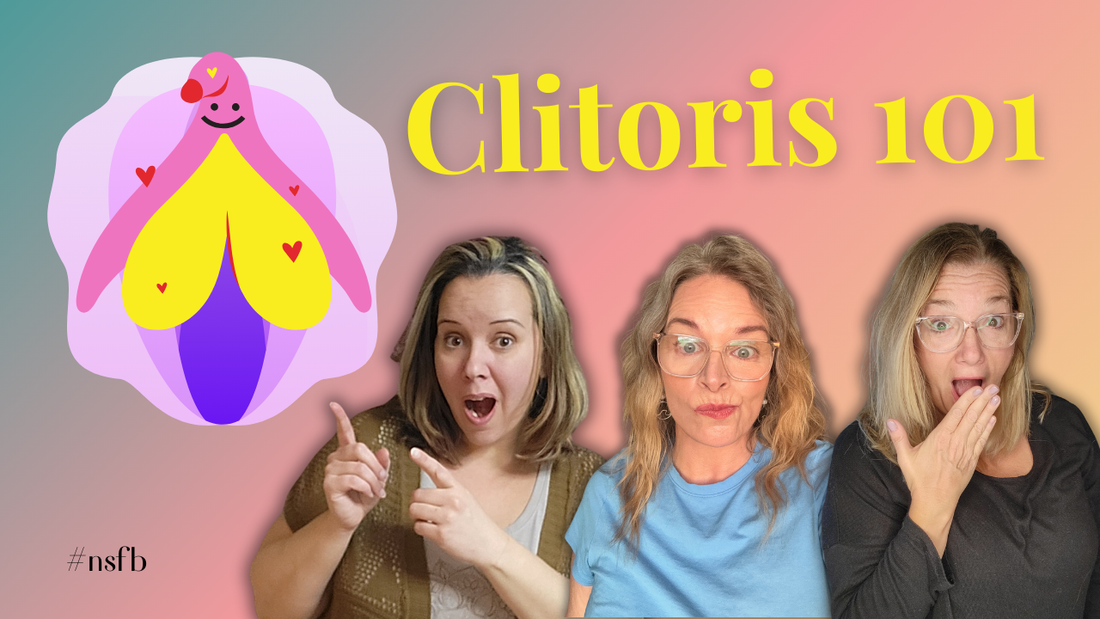
Episode 10: Clitoris 101: Your Guide to Pleasure and Anatomy
Share
When it comes to female pleasure, misinformation and lack of education have left many in the dark about how the vulva and clitoris actually work. Despite its vital role in pleasure, the clitoris has historically been overlooked—even in medical literature.
The Vulva: More Than Meets the Eye
Before we zoom in on the clitoris, let’s take a moment to understand the full structure of the vulva. The vulva refers to all the external female genitalia, which includes:
- The Mons Pubis – The fatty pad of tissue above the pubic bone, often covered in pubic hair.
- The Labia Majora – The outer lips that protect the inner structures.
- The Labia Minora – The inner lips that may be exposed or tucked within the labia majora. Each person’s labia are unique—there’s no “one-size-fits-all” look.
- The Vestibule – The entrance to the vaginal canal, surrounded by sensitive nerve endings.
- The Urethral Opening – Located between the clitoris and vaginal opening, this is where urine exits the body.
- The Perineum – The area between the vaginal opening and the anus, rich in nerve endings.
The Clitoris: More Than Just the Tip
One of the biggest misconceptions about the clitoris is its size. Many believe it to be a tiny button-like structure at the top of the vulva, but in reality, the clitoris is much larger and mostly internal. Think of it like an iceberg—the tip is just what’s visible above the surface.
Breaking Down the Clitoral Structure:
- The Glans Clitoris – This is the part you can see, often peeking out from under the clitoral hood. It’s packed with nerve endings, making it highly sensitive.
- The Clitoral Hood – A protective layer of skin that covers the glans, retracting when aroused.
- The Body of the Clitoris – The portion that extends internally, connecting to the pubic bone.
- The Crura – These are the “legs” of the clitoris, extending down the sides of the vulva, measuring between 5-9 cm in length.
- The Vestibular Bulbs – These sit on either side of the vaginal opening and swell with arousal, enhancing pleasure.
The Clitoris and Pleasure: The Science Behind It
Unlike other parts of the body that serve multiple functions, the clitoris exists solely for pleasure. With between 8,000 - 10,000 nerve endings, it’s the most sensitive part of the female anatomy. When aroused, increased blood flow causes the entire clitoral structure to swell, heightening sensitivity and making stimulation feel even more intense.
Exploring What Feels Best
Because every clitoris is unique, what feels good for one person might not work for another. Some tips for discovering what works best:
- Indirect Stimulation – If direct clitoral touch is too intense, try using soft fabric, gentle rubbing, or focusing on areas around the glans, such as the crura or vestibular bulbs.
- Different Types of Touch – Experiment with light strokes, pressure, or circular motions to see what brings the most pleasure.
- Try a Variety of Toys – Airflow stimulators, wands, and internal-external vibrators can all provide different types of sensations.
- Engage the Brain – Sexual arousal isn’t just physical—reading erotic stories, watching sensual media, or engaging in fantasy can help enhance pleasure.
The Importance of Foreplay
One of the key takeaways from our discussion is that foreplay matters. Studies show that 12-15 minutes of foreplay significantly enhances arousal and pleasure. Activities like kissing, touching, and nipple stimulation all contribute to increased blood flow and heighten sensitivity, making orgasms more accessible.
Foreplay also plays a role in preparing the body—especially for those who are postmenopausal or experience vaginal dryness. Lubrication and gradual arousal can make intimacy more enjoyable and comfortable.
Multiple Orgasms? Yes, Please!
A common challenge for some individuals is sensitivity post-orgasm, which can make additional stimulation uncomfortable. However, with patience and gentle exploration, many can experience multiple orgasms by shifting focus to different parts of the clitoral structure rather than direct stimulation on the glans.
Breaking the Stigma: Why We Need to Talk About This More
Historically, discussions around female pleasure have been dismissed, overlooked, or labeled as taboo. Even medical textbooks have treated the clitoris as an afterthought. This lack of education has led many people—both those with vulvas and their partners—to misunderstand its function and importance.
By having open conversations, sharing experiences, and advocating for accurate sexual education, we can normalize discussions about pleasure and empower individuals to embrace their sexuality without shame.
Final Thoughts: Own Your Pleasure
The clitoris is an incredible part of the body, and understanding how it works is key to maximizing pleasure. Whether through solo exploration or with a partner, prioritizing what feels good and communicating those needs is essential.
So, the next time you’re at brunch with friends, bring up this little-known fact: The clitoris isn’t tiny—it’s a powerhouse of pleasure. Who knows? You might just start the most enlightening conversation of the day.
📖 Resources Mentioned: The Vagina Bible by Dr. Jen Gunter
